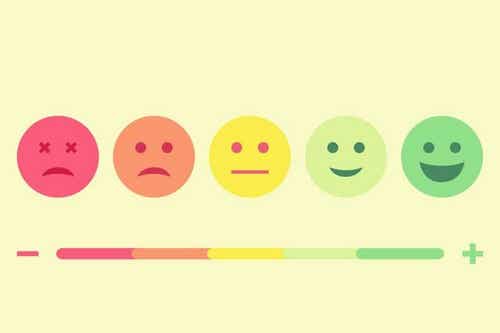The emotion thermometer is a tool that allows you to work with children on the identification, expression and management of emotions. We explain how to use it and why it is so useful!

Last update: June 20, 2021
Understanding emotions from an early age is essential to get to know each other, to know what it feels like and how to manage your inner world. A tool for working on these important aspects in childhood is the thermometer of emotions.
In this article we explain what it is, how to use it and why it can be useful for the little ones. It is a tool that we can customize (adapting it to the child) and that helps to work on aspects such as the recognition and management of emotions.
What is the thermometer of emotions?
Using the emotion thermometer (or emotional thermometer) it is a very useful activity for working on emotions of children and adolescents. However, it is mainly used with children and people with intellectual disabilities.
It is a visual scale that regulates the intensity of our emotions and which is composed of images, drawings, photographs or emoticons. We can customize it to our liking and adapt it to age or to the group with which we are preparing to work.
What is it for?
A very useful tool in infant therapy or in the emotional education of the little ones. It can also be very useful with children who find it difficult to define the emotions they feel and to quantify their intensity.
On the one hand, therefore, it helps to identify, label and express emotions; on the other hand, to regulate the intensity of the emotions that the child feels, until reaching the point of "no return" (anger), usually on a scale of 1 to 5. Each number represents an emotion.
The scale of emotions: from 1 to 5
Typically the scale includes five emotions. The first is represented by a happy face and the last by an angry one. At the center are the intermediate emotions or the more “neutral” or mild ones, that they go from one emotional state (cheerfulness / happiness) to another (anger).
The idea is to understand where the child is and to teach him some useful strategies for managing anger. To get an idea, we can include the following emotions (of your choice) on a scale that goes from the least to the most intense:
- Happiness / cheerfulness.
- Boredom / doubt / slight uneasiness.
- Feeling annoyed (initial stage of anger).
- Anger.
- Anger, anger (increased intensity, as well as the "point of no return").
Who can benefit most from this tool?
While this is a win-win tool, it is especially designed for children. Visual support and pictures are of great help for the little ones, especially when they cannot express certain emotions or explain specific situations, as well as when they struggle to manage anger.
On the other hand, the emotion thermometer can offer particular benefits to those who cannot communicate with words (for example, people with intellectual disabilities or an autism spectrum disorder).
Also children who find it difficult to recognize and express emotions in words can take particular advantage of this tool. The same goes for adolescents with similar characteristics: even in this case it can give interesting results.
Types of emotion thermometer
It is a creative tool, which can be defined by following different patterns or images on the internet. However, the final touch will be up to us; we will adapt the technique to our preferences. There are several emotion thermometers depending on whether the following items are included:
- Photo.
- Images.
- Drawings.
- Emoticon.
- Real faces
- Other.
How to use the thermometer of emotions?
Some steps are essential to make the most of the benefits offered by this tool. Here, then, that it becomes essential to perform two simple actions.
Comment on each picture or drawing with the child
Once you have drawn your own emotion thermometer, the child is asked what he sees in each selected image, drawing or emoticon.
The aim is to encourage him to identify and describe in his own words (or with help, if you need it) every emotion or mood.
Establish an "action plan against anger"
The last emotion in the thermometer of emotions, the hottest, is anger (or rage). Another important step when using this tool with the child is to decide together which strategies to adopt in case they feel anger.
It is important to let him know that it is okay and okay to feel angry, but that the expression of anger must be measured. There are many strategies to be applied, including:
- Breathe deeply.
- Count to 10.
- Change room or head to your room and be alone.
- Write down what's going on.
- Practice the turtle technique.
- Change game (in case you are playing with a partner).
Conclusions
The emotion thermometer can become a fun tool for children. You can ask them to draw it, in order to make them feel an active part of the process.
The child, for example, can decorate it to his liking or use photographs of your face expressing different emotions. We will be able to take advantage of the realization of the thermometer to work on other emotional aspects and skills.
Do you believe that the thermometer of emotions can be useful to you? How do you plan to use it? The ideas proposed here are only indicative: everyone can adopt the technique to the following child and to her needs.
Like children, emotions heal when they are heard and appreciated.
-Jill Bolte Taylor-


























